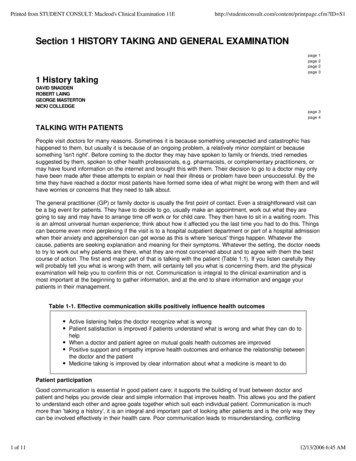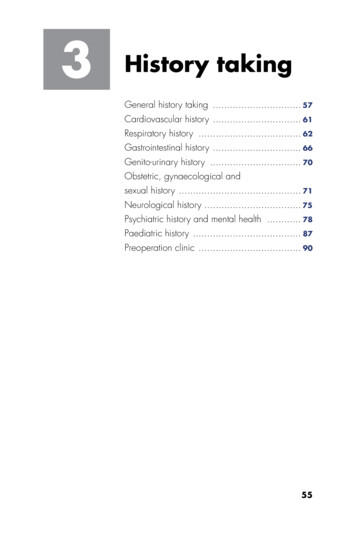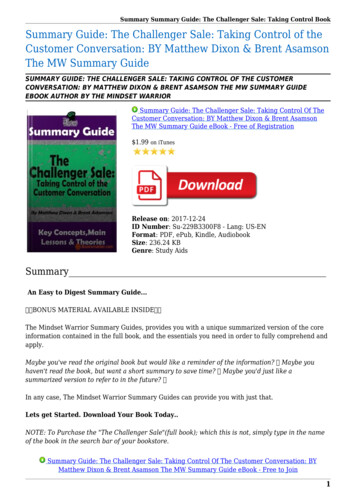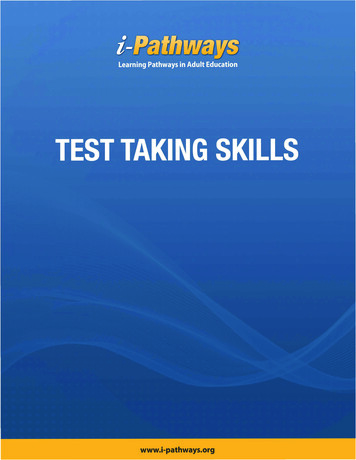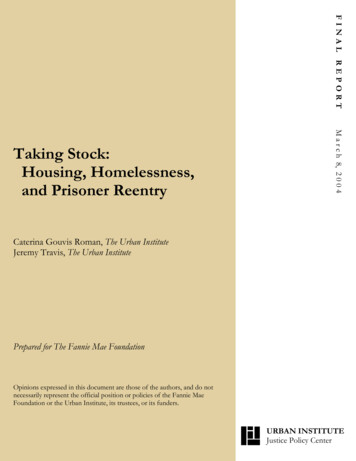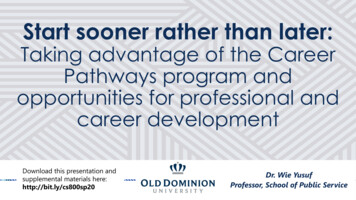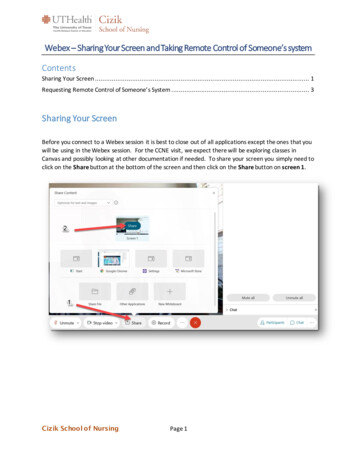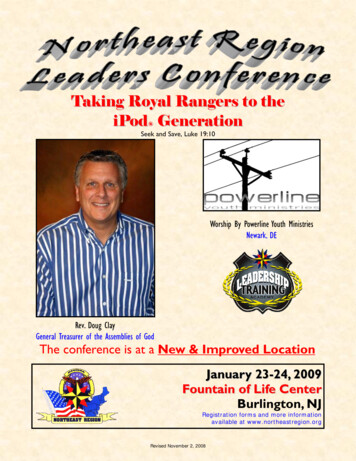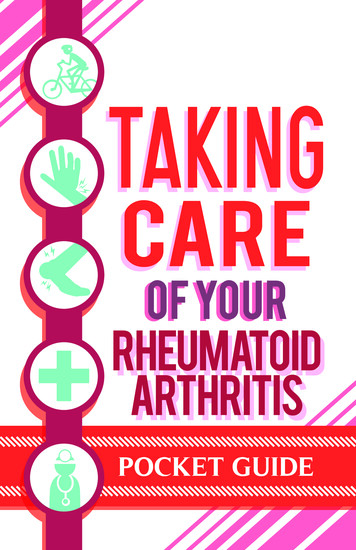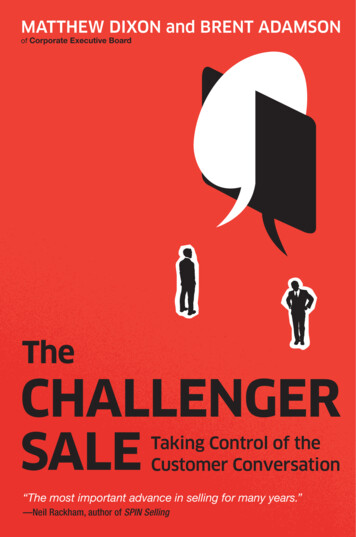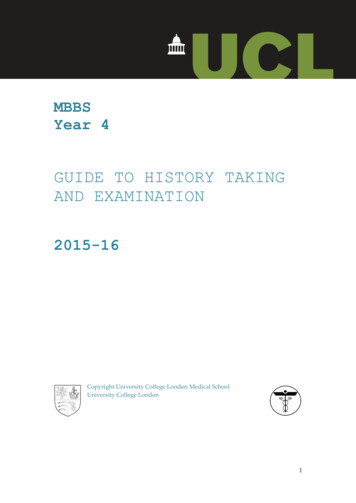
Transcription
MBBSYear 4GUIDE TO HISTORY TAKINGAND EXAMINATION2015-16Copyright University College London Medical SchoolUniversity College London1
ContentsThe Medical History .3How to take a Respiratory History .12How to take a Cardiovascular History .13How to take a Locomotor History .14How to take a history of pain .14Presenting patients Workshop .15General Tips on How to Perform an Examination .16Dress and Behaviour Expected in Clinical Area .18Cardiovascular Examination .19Respiratory Examination .24Abdominal Examination .26Musculoskeletal Examination- GALS Screen .30Motor Examination of Lower Limbs .32Examination of the Upper Limbs .35Sensory Examination of Lower Limbs .38Cranial Nerve Examination .41Ophthalmology - How to measure visual acuity .44Examination using an Ophthalmoscope with a patient.45How to record your clinical notes .47How to measure Blood Pressure 49How to perform urinalysis .50Originally by Kate Chatten, Mary Howe, Gillian Marks and Tom Smith. Edited andupdated by Henry Tufton, Dr Alison Sturrock and Dr Deborah Gill. Further updates DrJessica Bilaney, Dr Beth Walker, Dr Laura-Jane Smith and Mr David Gamble. Dr HelenNolan 2015 ACME 20152
The Medical History‘The medical history’ is a structured assessment conducted to generate a comprehensivepicture of a patient’s health and health problems. It includes an assessment of: the patient’s current and previous health problems current and previous medical treatment the patient’s health in general factors which might affect the patient’s health and their response to prevention ortreatment of health problems (e.g. risk factors, lifestyle issues) their family’s healthTaking together the history, information from the physical examination and anyinvestigations or tests, this should provide all the information needed to make a diagnosis(i.e. to identify the nature of a health problem). Making a diagnosis is often a preoccupationof clinical students, however, it is important to remember that a clerking (i.e. an assessment inwhich a medical history is taken) provides much more information than this. Thisconsultation should include questioning about the patient’s perspective of their situation (anoften-used mnemonic being ‘ICE’ - Ideas, Concerns and Expectations).The patient’s perspective affects: their response to information and recommended treatment the working relationship between the doctor (or team) and the patientRecent initiatives by the government and other institutions (e.g. the Department of Health’sNHS Plan, 2000; the GMC’s Duties of a Doctor) have emphasised the importance of involvingthe patient at every stage in their care.As a medical student you often have very defined goals: to practise how to ‘take a history’ to get information so you can identify a sensible differential diagnosis to give a clear case presentation to your firm to give a good impression to your consultant and colleaguesBe aware that as a doctor you will also need to consider: the impact of the patient’s health problem on their life the complex interplay between their current health problem, any chronic healthproblems, their lifestyle and risk factors, their social and family situation – and howthis affects their health in the long-term their short- and long-term relationship with health care providers, including you their response to information and recommended treatmentOriginally by Kate Chatten, Mary Howe, Gillian Marks and Tom Smith. Edited andupdated by Henry Tufton, Dr Alison Sturrock and Dr Deborah Gill. Further updates DrJessica Bilaney, Dr Beth Walker, Dr Laura-Jane Smith and Mr David Gamble. Dr HelenNolan 2015 ACME 20153
The Medical History – Common MisconceptionsThere is often confusion about what ‘a medical history’ is, because the term is used fordifferent things. It can mean: the whole consultation in which information is gathered (i.e. including both theprocess of communication, and the content, i.e. the information gathered) only the clinical content (the medical information) which is gleaned during theconsultation a written or presented version of the information gathered (e.g. in medical notes, astudent case presentation)These are all very different – the key point being that how you conduct a consultation togather information to obtain ‘a medical history’ is not the same as how you subsequentlyrecord it or communicate it to colleagues.Common problems1.Trying to gather the information in the order in which it is written or presented. Theinformation communicated to colleagues is a concise summary, presented in alogical, linear manner. Consultations, whilst structured, allow the information tounfold more slowly, often with parts being covered in a different order (e.g. thepatient may start their story with the onset of a problem some time ago, not theircurrent presenting symptom). Sometimes an additional line of questioning occurs toyou later, and you have to revisit a part of the history. In addition, there may bemuch clarification of terminology used – such as the patient’s description of theirsymptoms – which in the notes might be summarised simply as ‘complains ofpressing pain in chest’.You will have training in how to structure the consultation, but be aware that you arenot expected to cover everything in the same order in the consultation as in asubsequent case presentation.Example: At the start of a case presentation, you might begin with the patient’s age,gender, occupation and marital status. However, asking the patient’s occupation andmarital status as your second and third questions can appear intrusive and/orirrelevant - the patient is expecting to tell you about their medical problem first. It ismore appropriate to ask about these later on in the consultation, when you areopening up the discussion to talk more generally about their lifestyle.2.Clinical students become rapidly socialised into the use of medical jargon, which isthen unintentionally used with patients. Case presentations and medical notes arefull of jargon; it is concise. Consultations should not be.Example: The word ‘history’. You would not, in a consultation, start a line ofquestioning by saying ‘Now, what about your social history?’. You would say ‘I’djust like to ask you about your life in general, to get a better picture of your health.First of all, who’s at home with you? ’Other common jargon to avoid: ‘drugs’ (meaning prescribed or over the countermedication), and reading straight from a list whilst doing your systems review (e.g.‘anything associated with this?’, ‘does it radiate?’).Originally by Kate Chatten, Mary Howe, Gillian Marks and Tom Smith. Edited andupdated by Henry Tufton, Dr Alison Sturrock and Dr Deborah Gill. Further updates DrJessica Bilaney, Dr Beth Walker, Dr Laura-Jane Smith and Mr David Gamble. Dr HelenNolan 2015 ACME 20154
3.Experienced doctors obtain the clinical history in a problem-solving manner which isbased on testing a hypothesis. It is still necessary to ask all the usual questions abouta symptom (e.g. onset, course, severity, associated symptom, previous episodes etc.)but the format of the history of the presenting problem should be problem based. Inorder to perform the problem solving method competently, it is necessary to haveknowledge of the causes of each symptom and the symptoms of each disease. Thisstyle of history taking is something to work towards as you gain experience.The Medical History – Content and ProcessThe Professional Development Spine uses the Calgary-Cambridge Guide to the MedicalInterview, which integrates both the content (clinical information) and process(communication) of the consultation. A card summarising the Guide will be given out duringthe Introductory Course.Recommended further reading: Silverman J, Kurtz S, Draper J (2005) Skills for Communicating with Patients (2nd ed).Oxford: Radcliffe Publishing. (essential CalgaryCambridgeGuide.pdf (downloadablehandouts)Initiating the consultation1. Check the setting Find a chair (do not sit on the bed, do not stand over the patient) Consider ambient noise and privacy (can you be overheard?)2. Establish initial rapport Be approachable and friendly – it helps to begin with a smile and an ice-breaker (i.e. acomment about a non-medical topic) Greet the patient with their title and surname, and check you are using theirpreferred form of address Introduce yourself – full name and role (e.g. third year medical student) Explain reason for interview (e.g. to practise gathering information) Seek consent - if they decline, thank them and leave Seek consent for taking notes, explain information is passed on to doctor Demonstrate respect and interest, attend to the patient’s physical comfort andprivacy (e.g. would they like the curtain drawn?)3.Identify the reason for their attendance Open question to identify the patient’s current problem/reason for attending Listen attentively to the opening statement without interruption Acknowledge problem(s) mentioned (i.e. reflect back) Do not engage in detailed questioning at this point – you are establishing a problemlist Query whether there are other problems – acknowledge and repeat until no furtherproblems are mentioned Write down each problem as it is mentioned Summarise the problem list back to the patient5Originally by Kate Chatten, Mary Howe, Gillian Marks and Tom Smith. Edited andupdated by Henry Tufton, Dr Alison Sturrock and Dr Deborah Gill. Further updates DrJessica Bilaney, Dr Beth Walker, Dr Laura-Jane Smith and Mr David Gamble. Dr HelenNolan 2015 ACME 2015
Negotiate an agenda / explain your wish to gather information about the problems indetail and their health in generalKeynote: The problems that patients mention may not all be symptoms – they may bequestions or concerns. You are not expected to solve these and must not ignore them. Youshould gather information about them – in the same way as you do for the other problems –and explain that you will then pass this on to their doctor.Gathering information1. Explore the patient’s problems Encourage the patient to tell the story from when it first started Use open questions at the start, clarifying with closed questions later Show that you are listening – make eye contact while the patient is talking, tailoryour questions to the information being given, reflect back what the patient is sayingand periodically summarise Encourage the patient to talk – if you leave space, the patient will talk Pick up verbal and non-verbal cues indicating that there is something else the patientwants to say Clarify statements and any jargon used by the patient Use concise, easily understood language2. Understand the patient’s perspective Determine, acknowledge and appropriately explore:o the patient’s ideas and concernso the patient’s expectationso how each problem affects the patient’s life Encourage expression of the patient’s feelingsKeynote: New clinical students often feel embarrassed about asking about a patient’s feelings,expectations or concerns. Ask about these aspects in the same, matter-of-fact way as you askabout other aspects of the history. If you feel comfortable asking the questions, the patient ismore likely to feel comfortable about answering.Providing structure to the consultation1. Know what information you need have the main headings of the history and lists of any systems-specific questions infront of you2. Take notes take brief notes during the consultation itself3. Make organisation overt signpost - explain what the next section addresses summarise periodically (e.g. after each section)4. Attend to flow address topics in a logical sequence (and signpost for the patient) attend to timing – be clear and honest with the patient about duration of theconsultationOriginally by Kate Chatten, Mary Howe, Gillian Marks and Tom Smith. Edited andupdated by Henry Tufton, Dr Alison Sturrock and Dr Deborah Gill. Further updates DrJessica Bilaney, Dr Beth Walker, Dr Laura-Jane Smith and Mr David Gamble. Dr HelenNolan 2015 ACME 20156
if the consultation digresses, gently redirect – explain why certain information isneededKeynote: Taking notes: say what you are writing as you write it – it reassures the patient thatyou have heard and are recording the information correctly, and prevents note-taking frominterrupting the flow of the consultation.Building the relationship1. Develop rapport accept the patient’s views and feelings non-judgementally use empathy - acknowledge feelings and their predicament be supportive deal sensitively with embarrassing or disturbing topics, and pain2. Involve the patient share your thinking with the patient explain the rationale for your questions during physical examination, explain the process and ask permission3. Respond to the patient’s needs e.g. if the patient seems in discomfort, or tired, or in pain, acknowledge this andrespond
style of history taking is something to work towards as you gain experience. The Medical History – Content and Process The Professional Development Spine uses the Calgary-Cambridge Guide to the Medical Interview, which integrates both the content (clinical information) and process (communication) of the consultation. A card summarising the Guide will be given out during
